Berkshire Hathaway Chairman Warren Buffett has called cryptocurrencies “rat poison.” But with its characteristic eye for opportunities, Berkshire has also invested $1 billion in Nubank, a Brazil-based neobank whose investment unit, NuInvest, allows users to put money in a Bitcoin exchange-traded fund.
Buffett exemplifies the conflicting, even opposite, views in vogue towards cryptocurrency assets. Even as governments and central banks acknowledge that the blockchain technology that powers cryptocurrencies can revolutionise businesses and the way people live and work, they also worry that cryptocurrency is designed to bypass established financial systems, even the sovereign—the meaning of ‘crypto’ being ‘concealed; secret’. Cryptos, along with decentralised finance and non-fungible tokens (NFTs), use blockchain technology or democratised databases to ensure decentralised record-keeping, authentication and transaction tracking (see All About Cryptos).
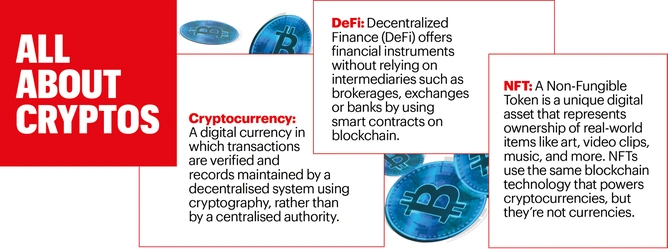
So, after years of caution that prevented them from giving cryptos legal cover, governments have decided to join the party and launch their own cryptocurrencies. The aim is to stymie development of big unregulated markets, prevent misuse for money laundering and terror financing and ensure control. After all, to the chagrin of governments and central banks, cryptocurrency, led by the most popular Bitcoin, has caught the fancy of investors across the world, leading to development of a market on the lines of the stock market, albeit without underlying assets or a safety net that normally accompanies any regulatory oversight. The trend continues to befuddle both governments and central banks. Can their plans to launch own cryptocurrencies override this new asset market whose sole aim is democratisation of currency and ensure it is not controlled by any one authority?
India’s Cryptocurrency and Regulation of Official Digital Currency Bill, 2021, introduced in winter session of Parliament (November 2021), seeks a framework for creation of an official digital currency by Reserve Bank of India (RBI). Also, a ban on private cryptocurrencies but with some exceptions to enable use of the underlying blockchain technology.
Advantage Digital Rupee
Central banks of different countries are pushing to adopt the national digital currency mechanism at the earliest. RBI is working to operationalise India’s central bank digital currency (CBDC) in FY2023. To start with, it will cater to the wholesale segment. And will be opened for retail use in due course. Russia, Sweden, China, Jamaica, Canada, U.S., U.K. and Mexico are also at various stages of introducing national digital currencies. In April 2020, China became the first large economy to test a digital currency, e-CNY.
As of March 2022, as many as 87 countries were looking at issuing CBDC, according to Washington-based Atlantic Council. Out of these, nine—The Bahamas, Nigeria and seven countries in Eastern Caribbean Union—have already launched their digital currencies.
India’s sovereign-backed CBDC, or digital rupee, will have trappings and trust level of physical rupee and ride the latest technologies. It is expected to be faster, cheaper, transparent and secure. It will be able to support cross-border trade and at the same time take banking to unbanked areas at least possible cost. In the process, it is expected to address regulatory concerns over cryptos and bring the central bank back to the centre of the financial system. India has already taken big strides in digitisation of financial access through systems such as UPI, NEFT and RTGS. CBDC will increase turnover of funds/money manifold. “CBDC, due to its inherent potential of changing the way value transfer happens, will provide a more resilient, innovative and competitive payment system for households, businesses and economies. Considering global case studies and given India’s progress on payments, digital rupee is likely to see early acceptance and commercialisation,” says Monish Shah, partner, Deloitte India.
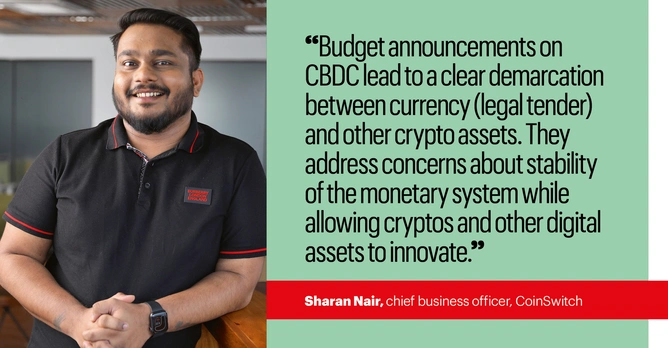
First-Mover Advantage
Like in a race, early birds will enjoy several advantages such as less competition while promoting local currency in global markets. They will also be able to help their banks lead in emerging technologies and ecosystems.
Can regulators utilise existing digital infrastructure? If yes, to what extent? Or, should they replace existing infrastructure completely and adopt latest technologies that can be relied upon for a longer period? “Banks and other financial services players need to prepare for this new asset class, its impact on their balance sheets as well as customer value propositions, apart from the benefits in terms of atomic transactions and risk mitigation,” says Shah of Deloitte India.
At this juncture, blockchain technology has to face an important test—is it amenable to systems and controls being proposed by regulators? “Central banks have to make choices between token-based or account-based approach; retail CBDC and/or wholesale CBDC; interest-bearing CBDC or non-interest-bearing CBDC,” Deloitte India says in a recent report.
Use cases proposed by central banks cover securities settlement in capital markets, cross-border payments, instant domestic payments, instant peer-to-peer wallet transactions, large value transactions and settlement, programmable money, MSME lending, offline payments, among others. If these come to fruition, the financial sector is set for phenomenal changes in the foreseeable future.
The War Push
It is the trade and financial sanctions imposed on Russia for invading Ukraine that fast-tracked CBDCs. Russia had banned cryptos in January 2022. In February 2022, it completed initial trials of its CBDC, known as the ‘digital rouble’. Since then, it has been trying to build a comprehensive legal framework for crypto transactions, even as U.S. and E.U. are trying to plug loopholes in sanctions, which include excluding Russian banks from accessing international money transfer platform SWIFT.
Experts say sanctions are encouraging countries to use cryptos for international trade and financial transactions. Ukraine has been increasingly relying on cryptos to fund its defence expenditure. Shortly before hostilities began, its Parliament adopted a law on virtual assets to regulate the crypto space. According to analysts, number of investors owning more than 1,000 bitcoins has spiked globally. Even investment banks and asset managers are evincing interest in cryptos, the latest being the world’s largest asset manager, Blackrock.
“Ukraine’s legalisation is another historic milestone for the crypto industry. We hope that it inspires India to recognise the vast potential for positive change that crypto and blockchain bring and leads to creation of a progressive regulatory framework that will protect investors and promote innovation in this category,” says Avinash Shekhar, CEO, ZebPay a crypto platform.
Regulatory Scrutiny
Though cryptocurrency exchanges and Blockchain and Crypto Assets Council claim that about 20 million Indian investors own an estimated $5.3 billion through around 15 platforms, no agency tracks the volume and value of cryptos traded. In early February 2022, the market capitalisation of 17,436 cryptocurrencies traded on 458 exchanges globally was estimated at $1.98 trillion. “Our data shows that we continue to see good traction on CoinDCX with respect to rupee deposits and buying/selling of cryptos,” says Minal Thukral, EVP, growth & strategy, CoinDCX, adding that CBDCs would spur growth in cryptocurrencies.
The Indian market cannot be segregated from the global universe given that most exchanges here offer globally established cryptos like Bitcoin, the global leader, followed by Ethereum, Cardano, Dogecoin, Tether and Stellar.
However, cryptos have been dogged by high volatility, say analysts. Besides, they have failed as safe haven assets and/or hedge against inflation. That is one of the reasons for increasing regulatory scrutiny. The FY2023 Union Budget taxed virtual digital assets like cryptocurrencies and NFTs. It proposed a 30% tax on gains as well as 1% tax deducted at source on every transaction for purportedly tracking investor activity and collecting data for policy and regulatory purposes.
The taxation would hurt investors but industry players are unanimous in seeking regulatory guidelines for cryptos, stating that this will bring trust and safety to the market and standardise best practices, making it easier for them to enlist newcomers. Right now, cryptocurrency is neither regulated nor prohibited in India.
Sharan Nair, chief business officer, CoinSwitch, reads the Budget proposals differently. “Budget announcements on CBDC lead to a clear demarcation between currency (legal tender) and other crypto assets. They address concerns about stability of the monetary system while allowing cryptos and other digital assets to innovate.” Besides, the use case of CBDCs is payments, while crypto assets are investment tools like stocks, he says.
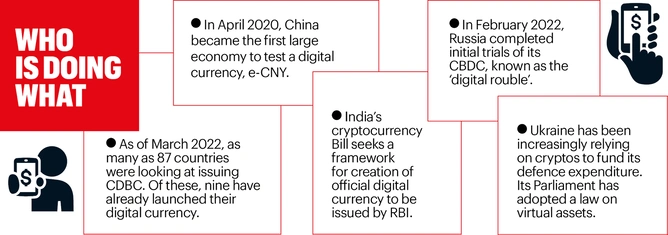
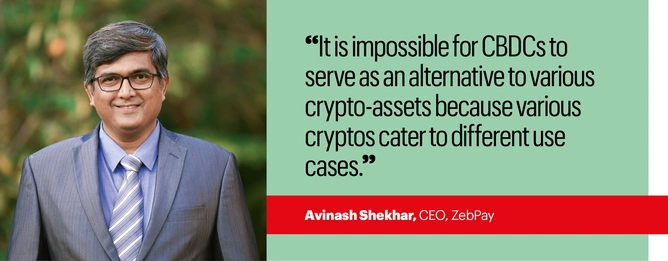
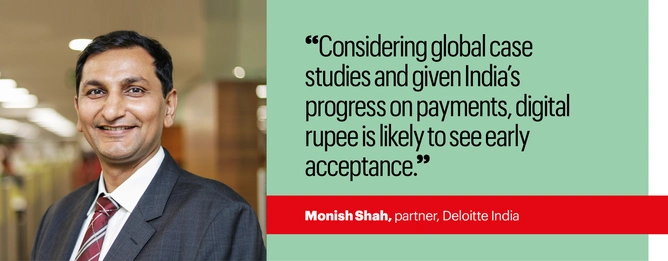
Crypto Concerns
In February, T. Rabi Sankar, deputy governor, RBI, highlighted two fundamental drawbacks of cryptos—they are intended to be private currencies and structured to evade government control with respect to financial integrity standards such as know-your-customer (KYC), anti-money laundering (AML) and countering financing of terrorism (CFT) regulations. This explains the regulator’s caution in dealing with the subject.
Another question is: Does cryptocurrency really function like a currency? Physical currency is authenticated by the receiver. Digital payments are authenticated by an intermediary such as a bank. But crypto players want to create their own private currency and transaction arrangement that bypasses banks. Currency always has an issuer, usually a trusted entity like sovereign or central banks. Cryptocurrencies do not conform to this understanding.
They do not come under the definition of an asset or a commodity too as they have no underlying cash flows or intrinsic value. They are akin to Ponzi schemes, and may even be worse, says Sankar. While these should be reason enough to keep them off the formal financial system, they can still undermine financial integrity, especially KYC and AML/CFT regulations. In March 2022, Minister of State for Finance Pankaj Chaudhary told Parliament that Enforcement Directorate is investigating seven cases under PMLA 2002 in which cryptocurrency has been used for money laundering.
If allowed they can wreck the currency system, the monetary authority, the banking system, and in general the government’s ability to control the economy. Being susceptible to strategic manipulation by private corporates creating these currencies or governments that control them, they can threaten a country’s financial sovereignty. Citing all these reasons, Rabi Sankar suggested that “banning cryptocurrency is perhaps the most advisable choice open to India.”
The International Monetary Fund (IMF) has also expressed concerns: “Many of these entities lack strong operational, governance and risk practices. Crypto exchanges, for instance, have faced significant disruptions during periods of market turbulence. There are also several high-profile cases of hacking-related theft of customer funds,” it said in a recent report.
In India, RBI has been warning the public against investing in unregulated cryptos since 2013. It went on to prohibit its regulated entities, including banks, from dealing in virtual currencies in April 2018, though the circular was set aside by the Supreme Court in March 2020. Since then, government and RBI have been moving cautiously, leaving them unregulated; hence, the urgency for an alternative mechanism.
However, total regulation may not be as easy as it seems. As Avinash Shekhar of ZebPay says, “It is impossible for CBDCs to serve as an alternative to various crypto-assets because various cryptos cater to different use cases.” Some, such as Bitcoin, are a store of value, while others like Ethereum and Solana are also ecosystems that allow for creation of decentralised applications.
Government realises that a huge disruption is coming their way. Its response will decide whether India gets a head start in tapping the technological opportunities at hand.







Leave a Comment
Your email address will not be published. Required field are marked*